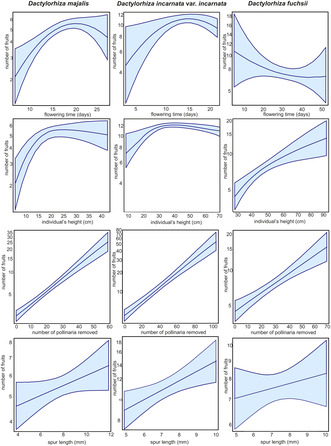- Record: found
- Abstract: found
- Article: found
What are the drivers of female success in food‐deceptive orchids?

Read this article at
Abstract
A large suite of floral signals, and environmental and biotic characteristics influence the behavior of pollinators, affecting the female success of food‐deceptive orchids. In this study, we examined the many factors shaping the reproductive output of three orchid taxa: Dactylorhiza majalis, D. incarnata var. incarnata, and D. fuchsii. We applied a statistical model to correlate female success (number of fruit sets) with individual characteristics (plant and inflorescence height, number of flowers, and spur length), number of pollinaria removed, flowering time, and density of floral units of co‐flowering rewarding plants. Our findings suggested that the broad spectrum of variations in Dactylorhiza's morphological traits, floral display, and flowering phenology within different environmental contexts has a significant impact on their reproductive success. The number of fruits increased with an increase in the number of pollinaria removed in the studied Dactylorhiza taxa. In contrast, a higher number of flowers per inflorescence and higher inflorescences in relation to individual height always decreased fruit set. We observed that low number of co‐flowering rewarding plants in populations could affect the Dactylorhiza reproductive output as magnets and competitor plants. The synchronization of flowering, or lack thereof, between Dactylorhiza and rewarding plants can limit reproductive success. This demonstrates that the food deception strategy is multidirectional, and reproductive output can vary considerably both spatially and temporally within the context of this strategy.
Abstract
We observed that a wide range of variations in Dactylorhiza morphological traits, floral display, and flowering phenology in an environmental context affects Dactylorhiza's reproductive success. In contrast, a higher number of flowers per inflorescence and higher inflorescences in relation to individual height always decreased female success. The low number of co‐flowering rewarding plants in populations could shape the Dactylorhiza fruits set as magnets and competitor plants. The lack of synchronized flowering between Dactylorhiza and rewarding plants limits reproduction. This demonstrates that the food deception strategy is multidirectional, and reproductive output can vary considerably spatially and temporally within the context of this strategy.
Related collections
Most cited references69
- Record: found
- Abstract: not found
- Book: not found
R: A Language and Environment for Statistical Computing
- Record: found
- Abstract: not found
- Article: not found
Variation in sexual reproduction in orchids and its evolutionary consequences: a spasmodic journey to diversification
- Record: found
- Abstract: found
- Article: not found

